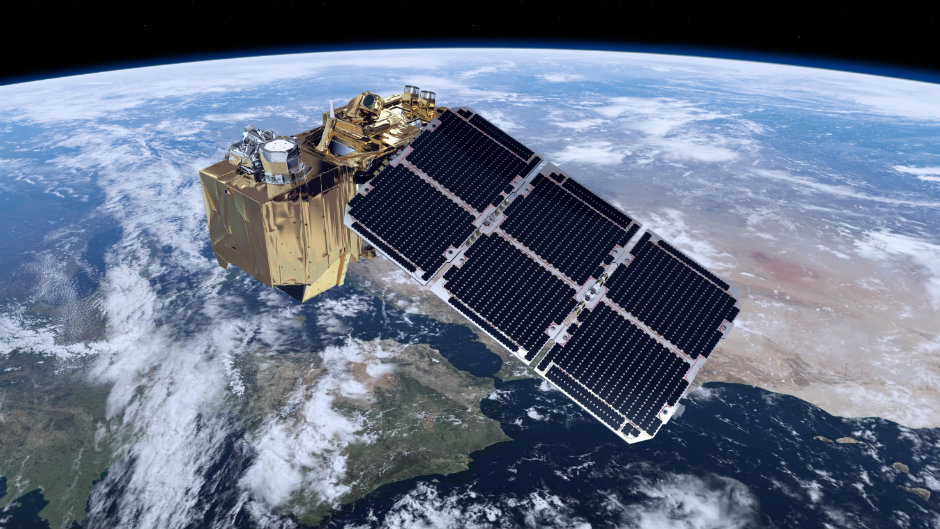Leonardo 07 March 2017
| Sentinel 2B in orbit |
From the forests to the icebergs, from cultivated fields right down the details of a single leaf: our planet has never before been monitored with such precision. Thanks to Sentinel-2B, the latest satellite launched into orbit as part of Copernicus, the European satellite observation programme that gives Europe the ability to identify and manage information on the state of the Earth’s health; it will be possible to obtain the most detailed images ever captured of the Earth’s vegetation.
Sentinel-2B, Copernicus’ fifth environmental sentinel, was launched from Kourou, the European spaceport in French Guiana, on board the Vega rocket, in order to reach in orbit its twin satellite, Sentinel 2A, operational since June 2015. The sentinel will provide high-resolution optical imagery of vegetation, land and water, as well as useful information in the event of emergencies.

| Leonardo’s role in the Copernicus Programme |
Leonardo takes part in the programme with its joint ventures Thales Alenia Space and Telespazio, as well as with the Airborne & Space Systems Division. In particular, Thales Alenia Space is responsible, as prime contractor, for the constellations for the Sentinel-1 and Sentinel-3 missions. The two satellites, Sentinel-1A (launched in April 2014) and Sentinel-1B (launched in April 2016), are designed and integrated entirely by Thales Alenia Space Italia, to obtain imagery of the Earth over areas of between 20 and 250 kilometres in size, with a resolution of between 5 and 25 metres. They are equipped with C-Band Synthetic Aperture Radar, capable of providing users with continuous imagery, day and night, in all weather conditions. The European Space Agency (ESA) has ensured the continuity of the Sentinel-1 and Sentinel-3 missions, entrusting Thales Alenia Space with the design, development and integration of satellites Sentinel 1C and 1D (with Thales Alenia Space Italia as prime contractor) and Sentinel 3C and 3D (with Thales Alenia Space France as prime contractor).
Sentinel-1 satellites are fitted with attitude sensors and power units produced by Leonardo’s Airborne & Space Systems Division, whilst Sentinel-3, whose first satellite was launched on 16 February 2016, is fitted with SLSTR radiometers (capable of measuring the temperature of oceans and of the earth from a height of 800 km and with a precision of one tenth of a degree) and with photovoltaic panels, also on board the precursor, Sentinel-5.
Telespazio is one of the Copernicus Programme’s main industrial partners . The Company is involved in the production, maintenance and development of the Payload Data Ground Segment (PDGS) for the Sentinel-1 and Sentinal-3 missions (through Telespazio VEGA Deutschland), of the Mission Control System of Sentinel-1, Sentinel-2, Sentinel-3 and Sentinel-5P, and of Earth observation product access infrastructure of the missions (Copernicus Space Component Data Access/Coordinated Data Access System - CSCDA/CDS). In the operations sector, Telespazio provides its own personnel to support ESOC during the pre- and post-launch stages of Sentinel satellites and is responsible for the CSCDA/CDS operations, as well as for the acquisition of Sentinel-1 and Sentinel-2 mission data from its Matera Space Centre (through the subsidiary e-GEOS). Furthermore, Telespazio is responsible, until 2021, for operations management of the Sentinel-3 mission ground segment. In the services sector, Telespazio is active (through the subsidiaries e-GEOS, GAF and Telespazio VEGA UK) in the management of emergencies, land and maritime security, the management of land resources and the monitoring of climate change. Finally, Telespazio provides Earth observation data to the Copernicus programme from the COSMO-SkyMed and IRS missions.

| Telespazio’s role for Sentinel 2B |
Telespazio supported ESA in the delicate stages that preceded the launch into orbit of the programme’s fifth environmental sentinel. The engineers at Telespazio VEGA Deutschland, a subsidiary of Telespazio, gave their support to the ESOC Flight Control team, with services for the preparation, launch and control of the satellite. Telespazio VEGA Deutschland also provided a simulation service for the training of personnel involved in flight control operations and is responsible for the development of certain instruments essential for the use of data produced by the Multispectral Imaging system (MSI) on board the satellite.
The role of Telespazio did not conclude with the satellite’s launch into orbit: the Company, which contributes to the development of the ground segment and Copernicus’ operations, collaborates (through the subsidiaries e-GEOS, GAF and Telespazio VEGA UK) with the management of emergencies, land and maritime security and monitoring climate change, providing the programme with data from the COSMO-SkyMed and IRS satellites. In particular, the e-GEOS Matera Space Centre is one of the Copernicus Core Ground Segment’s three stations and receives radar and optical data gathered by the Sentinel-1 and Sentinel-2 missions.

